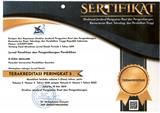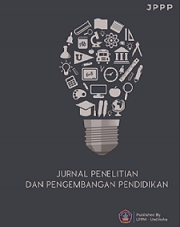Stock and Sauce Teaching Materials for European Culinary Courses: Vocational Education
DOI:
https://doi.org/10.23887/jppp.v8i2.68658Keywords:
Development, Teaching Materials, Stock and Sauce, ADDIEAbstract
This research is motivated by learning less effective activities because educators must provide detailed information while teaching materials could be more supportive. In addition, the lack of teaching materials will make it difficult for students to carry out learning activities outside of learning hours. The research aimed to develop learning materials related to broth and sauce in European culinary courses. The study used a research and development design adapted to the ADDIE model (analysis, design, development, implementation, and evaluation). The subjects involved in this study were third-semester students of the Tata Boga study program selected by total sampling because the number of students was less than 100. The data collection methods used were document analysis, observation, interview, and questionnaire distribution. Then, the data were analyzed quantitatively and qualitatively. The research findings show that the learning materials developed as e-modules cover students' attitudes, cognition, and skills. The developed product is very feasible and has positive student responses.
References
Abadi, R. F., & Asmiati, N. (2020). Pengembangan Bahan Ajar Berbasis Blended Learning Pada Program Studi Pendidikan Khusus Di Universitas Sultan Ageng Tirtayasa. Jurnal Elementaria Edukasia, 3(2), 344–354. https://doi.org/10.31949/jee.v3i2.2505. DOI: https://doi.org/10.31949/jee.v3i2.2505
Amanda, C., Miranti, M. G., Sutiadiningsih, A., & Bahar, A. (2023). Pengembangan E-Modul Makanan Asia Timur Berbasis Flip Builder Untuk Siswa Program Keahlian Kuliner SMKN 1 Cerme Gresik. Jurnal Pendidikan dan Ilmu Sosial, 1(4), 57–76. https://doi.org/10.54066/jupendis.v1i4.864. DOI: https://doi.org/10.54066/jupendis.v1i4.864
Apsari, A. N., & Kustijono, R. (2017). Development of e-book using kvisoft flipbook maker to train science process skill for senior high school students in curriculum 2013. Jurnal Inovasi Pendidikan Fisika (JIPF), 06(03), 285–291. https://doi.org/10.26740/ipf.v6n3.p%25p.
Branch, R. M. (2009). Approach, Instructional Design: The ADDIE. Springer. DOI: https://doi.org/10.1007/978-0-387-09506-6
Budi, S. S., & Miaz, Y. (2023). Multimedia Interaktif Berbasis Aplikasi Adobe Flash CS6 pada Pembelajaran Tematik. Jurnal Penelitian dan Pengembangan Pendidikan, 7(2), 264–272. https://doi.org/10.23887/jppp.v7i2.63129. DOI: https://doi.org/10.23887/jppp.v7i2.63129
Darma, I. K., Karma, I. G. M., & Santiana, I. M. A. (2020). Blended Learning, Inovasi Strategi Pembelajaran Matematika di Era Revolusi Industri 4.0 Bagi Pendidikan Tinggi. Prosiding Seminar Nasional Pendidikan Matematika, 3, 527–539. https://journal.unnes.ac.id/sju/index.php/prisma/article/view/37580.
Dewi, F. F., & Handayani, S. L. (2021). Pengembangan Media Pembelajaran Video Animasi En-Alter Sources Berbasis Aplikasi Powtoon Materi Sumber Energi Alternatif Sekolah Dasar. Jurnal Basicedu, 5(4), 2530–2540. https://doi.org/10.31004/basicedu.v5i4.1229. DOI: https://doi.org/10.31004/basicedu.v5i4.1229
Dharmayani, N. P. A. G., Agung, A. A. G., & Wiyasa, I. K. N. (2023). Multimedia interaktif berbasis pendekatan saintifik efektif meningkatkan kompetensi pengetahuan IPA. Jurnal Penelitian dan Pengembangan Pendidikan, 7(2), 317–327. https://doi.org/10.23887/jppp.v7i2.54767. DOI: https://doi.org/10.23887/jppp.v7i2.54767
Dwi Novita, R., Tien Aminatun, & Rihab Wit Daryono. (2022). E-Modules Through Flipped Classroom and PBL Models on Environmental Pollution Material to Increase Problem-Solving Ability. Journal of Education Technology, 6(4), 744–754. https://doi.org/10.23887/jet.v6i4.51656. DOI: https://doi.org/10.23887/jet.v6i4.51656
Dwiqi, G. C. S., Sudatha, I. G. W., & Sukmana, A. I. W. I. Y. (2020). Pengembangan Multimedia Pembelajaran Interaktif Mata Pelajaran IPA Untuk Siswa SD Kelas V. Jurnal Edutech Undiksha, 8(2), 33. https://doi.org/10.23887/jeu.v8i2.28934. DOI: https://doi.org/10.23887/jeu.v8i2.28934
Galih Pranowo. (2021). Monograf Pengelolaan Pembelajaran Mata Pelajaran Produktif Kelas Nautika (S. Fauziyah (ed.); I). Lakeisha.
Herawati, N. S., & Muhtadi, A. (2018). Pengembangan modul elektronik (e-modul) interaktif pada mata pelajaran Kimia kelas XI SMA. Jurnal Inovasi Teknologi Pendidikan, 5(2), 180–191. https://doi.org/10.21831/jitp.v5i2.15424. DOI: https://doi.org/10.21831/jitp.v5i2.15424
Indarta, Y., Dewi, I. P., Ambiyar, Syahril, Fadhilah, Asnur, L., Ranuharja, F., & Samala, A. D. (2021). Development of E-Module Courses Tata Boga 2 Based on Flip PDF Professional for Teaching Learning Process in The Pandemic of Covid 19. Advances in Social Science, Education and Humanities Research, 608, 174–179. https://doi.org/10.2991/assehr.k.211208.029.
Istri, C., Marsiti, R., Santyasa, I. W., Sudatha, I. G. W., & Komang, I. (2022). multimedia for culinary students : food and beverage processing subject. Journal of Education Technology, 6(4), 733–743. https://doi.org/10.23887/jet.v6i4.53518. DOI: https://doi.org/10.23887/jet.v6i4.53518
Lase, D. (2019). Pendidikan di era revolusi industri 4.0. Jurnal Ilmiah Teologi Pendidikan Sains Humaniora, 1(1). https://doi.org/10.36588/sundermann.v1i1.18. DOI: https://doi.org/10.36588/sundermann.v1i1.18
Lestari, S. (2018). Peran Teknologi Dalam Pendidikan Di Era Globalisasi. Jurnal Pendidikan Agama Islam, 2(2), 94–100. https://doi.org/10.33650/edureligia.v2i2.459. DOI: https://doi.org/10.33650/edureligia.v2i2.459
Maulana, A., Puspita, A. J., Pangastuti, K. K., Daryati, D., & Arthur, R. (2022). The Concept of Literacy Vocational-Based E-Module of Technical Mechanical Subject. Journal of Physics: Conference Series, 2377(1). https://doi.org/10.1088/1742-6596/2377/1/012068. DOI: https://doi.org/10.1088/1742-6596/2377/1/012068
Puspitasari, R., Hamdani, D., & Risdianto, E. (2020). Pengembangan E-Modul Berbasis Hots Berbantuan Flipbook Marker Sebagai Bahan Ajar Alternatif Siswa Sma. Jurnal Kumparan Fisika, 3(3), 247–254. https://doi.org/10.33369/jkf.3.3.247-254. DOI: https://doi.org/10.33369/jkf.3.3.247-254
Putri, N. P. D. A. M., & Suartama, I. K. (2022). Modul Pembelajaran Interaktif pada Mata Pelajaran Agama Hindu dan Budi Pekerti Kelas VI Sekolah Dasar. Jurnal Edutech Undiksha, 10(1), 184–194. https://doi.org/10.23887/jeu.v10i1.46716.
Rahayu, I., & Sukardi, S. (2021). The Development Of E-Modules Project Based Learning for Students of Computer and Basic Networks at Vocational School. Journal of Education Technology, 4(4), 398. https://doi.org/10.23887/jet.v4i4.29230. DOI: https://doi.org/10.23887/jet.v4i4.29230
Rahayu, R., Iskandar, S., & Abidin, Y. (2022). Inovasi Pembelajaran Abad 21 Dan Penerapannya Di Indonesia Restu Rahayu 1 , Sofyan Iskandar 2 , Yunus Abidin 3. Jurnal Basicedu, 6(2), 2099–2104. https://doi.org/10.31004/basicedu.v6i2.2082. DOI: https://doi.org/10.31004/basicedu.v6i2.2082
Rahmatunisa, N., Sofyan, H., Daryono, R. W., & Nurtanto, M. (2022). Feasibility of Clinical Dietetics E-Module to Improve Learning Achievement of Vocational Students. Journal of Education Technology, 6(1), 45–55. https://doi.org/10.23887/jet.v6i1.41542. DOI: https://doi.org/10.23887/jet.v6i1.41542
Redhana, I. W. (2019). Mengembangkan Keterampilan Abad Ke-21 Dalam Pembelajaran Kimia. Jurnal Inovasi Pendidikan Kimia, 13(1), 2239–2253. https://doi.org/https://doi.org/10.15294/jipk.v13i1.17824.
Sari, S. E., Susilawati, S., & Anwar, L. (2021). E-Module Development on Hydrocarbon Compounds Material for Class X Agricultural Vocational High School. Journal of Educational Sciences, 5(1), 36. https://doi.org/10.31258/jes.5.1.p.36-52. DOI: https://doi.org/10.31258/jes.5.1.p.36-52
Sarwandi, S., Giatman, M., Sukardi, S., & Irfan, D. (2019). Developing mobile-based project-based learning module for project management courses in vocational education. Jurnal Pendidikan Vokasi, 9(2), 207–216. https://doi.org/10.21831/jpv.v9i2.25947. DOI: https://doi.org/10.21831/jpv.v9i2.25947
Sulistianingsih, A. ., & Carina, A. (2019). Developing Interactive E-book as Material Technology Coursebook by Flipbook Maker Software. Journal of Education and Practice, 1735, 11–17. https://doi.org/10.7176/jep/10-24-03. DOI: https://doi.org/10.7176/JEP/10-24-03
Sumardi, L., Rohman, A., & Wahyudiati, D. (2020). Does the teaching and learning process in primary schools correspond to the characteristics of the 21st century learning? International Journal of Instruction, 13(3), 357–370. https://doi.org/10.29333/iji.2020.13325a. DOI: https://doi.org/10.29333/iji.2020.13325a
Tafonao, T. (2018). Peranan Media Pembelajaran Dalam Meningkatkan Minat Belajar Mahasiswa. Jurnal Komunikasi Pendidikan, 2(2), 103. https://doi.org/10.32585/jkp.v2i2.113. DOI: https://doi.org/10.32585/jkp.v2i2.113
Winatha, K. R., & Abubakar, M. M. (2018). The Usage Effectivity of Project-Based Interactive E-Module in Improving Students’ Achievement. Jurnal Pendidikan Teknologi dan Kejuruan, 24(2), 198–202. https://doi.org/10.21831/jptk.v24i2.20001. DOI: https://doi.org/10.21831/jptk.v24i2.20001
Wulandari, N. P. D., & Wiarta, I. W. (2022). Media Pembelajaran Interaktif Sifat-Sifat Bangun Ruang Berbasis Guided Discovery Materi Kubus dan Balok. Jurnal Edutech Undiksha, 10(1), 21–32. https://doi.org/10.23887/jeu.v10i1.46270.
Yulianti, Y. A., & Wulandari, D. (2021). Flipped Classroom : Model Pembelajaran untuk Mencapai Kecakapan Abad 21 Sesuai Kurikulum 2013. Jurnal Kependidikan, 7(2), 372–384. https://doi.org/10.33394/jk.v7i2.3209. DOI: https://doi.org/10.33394/jk.v7i2.3209
Yulianto, T., Pramudya, İ., & Slamet, İ. (2019). Effects of the 21st Century Learning Model and Problem-Based Models on Higher Order Thinking Skill. International Journal of Educational Research Review, 4, 749–755. https://doi.org/10.24331/ijere.629084. DOI: https://doi.org/10.24331/ijere.629084
Downloads
Published
How to Cite
Issue
Section
License
Copyright (c) 2024 Cok. Istri Raka Marsiti, Ni Sukerti

This work is licensed under a Creative Commons Attribution-ShareAlike 4.0 International License.
Authors who publish with the Jurnal Penelitian dan Pengembangan Pendidikan agree to the following terms:
- Authors retain copyright and grant the journal the right of first publication with the work simultaneously licensed under a Creative Commons Attribution License (CC BY-SA 4.0) that allows others to share the work with an acknowledgment of the work's authorship and initial publication in this journal.
- Authors are able to enter into separate, additional contractual arrangements for the non-exclusive distribution of the journal's published version of the work (e.g., post it to an institutional repository or publish it in a book), with an acknowledgment of its initial publication in this journal.
- Authors are permitted and encouraged to post their work online (e.g., in institutional repositories or on their website) prior to and during the submission process, as it can lead to productive exchanges, as well as earlier and greater citation of published work. (See The Effect of Open Access)







